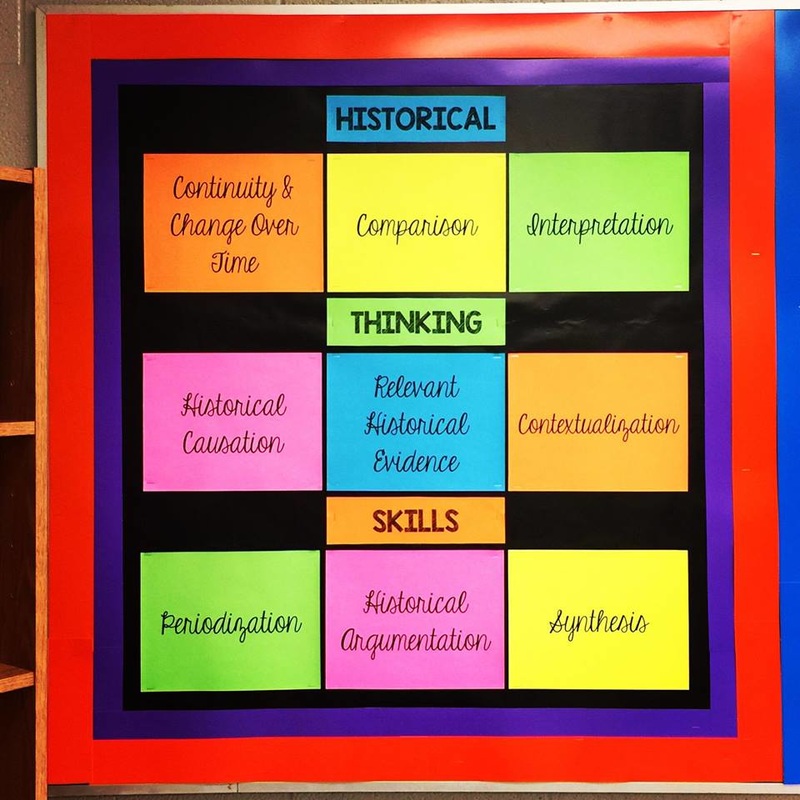Introduction to Historical Thinking Skills
The AP history courses seek to apprentice students to the practice of history by explicitly stressing the development of historical thinking skills while learning historical content. Students best develop historical thinking skills by investigating the past in ways that reflect the discipline of history, most particularly through the exploration and interpretation of a rich array of primary sources and secondary texts and through the regular development of historical argumentation in writing.
Watch the videos below from Paul Sargent to give yourself an understanding of the 4 Categories which make up the 9 Historical Thinking Skills which will be tested on the AP Exam. Student Resources are found at the bottom of the page
Watch the videos below from Paul Sargent to give yourself an understanding of the 4 Categories which make up the 9 Historical Thinking Skills which will be tested on the AP Exam. Student Resources are found at the bottom of the page
AP Euro Historical Thinking Skills
From the College Board: This section presents the historical thinking skills that students should develop in all AP history courses. The nine historical thinking skills are grouped into four categories: Analyzing Sources and Evidence, Making Historical Connections, Chronological Reasoning, and Creating and Supporting a Historical Argument.
Every AP Exam question will assess one or more of the skill-based proficiency expectations as well as one or more of the thematic learning objectives.
Below is an introduction to each of the four categories and the nine historical thinking skills as per The College Board and with special credit given to Paul Sargent, AP Euro Teacher and AP Government teacher.
Every AP Exam question will assess one or more of the skill-based proficiency expectations as well as one or more of the thematic learning objectives.
Below is an introduction to each of the four categories and the nine historical thinking skills as per The College Board and with special credit given to Paul Sargent, AP Euro Teacher and AP Government teacher.
1. Analyzing Historical Sources and Evidence
Primary Sources
|
Secondary Sources
|
2. Making Historical Connections
ContextualizationHistorical thinking involves the ability to connect historical events and processes to specific circumstances of time and place as well as broader regional, national, or global processes.
Students will be able to:
|
ComparisonHistorical thinking involves the ability to identify, compare, and evaluate multiple perspectives on a given historical event in order to draw conclusions about that event.
It also involves the ability to describe, compare, and evaluate multiple historical developments within one society, one or more developments across or between different societies, and in various chronological and geographical contexts. Students will be able to:
|
SynthesisThe College Board says the following about Synthesis: Historical thinking involves the ability to develop an understanding of the past by making meaningful and persuasive historical and/or cross-disciplinary connections between a given historical issue and other historical contexts, periods, themes, or disciplines.
We will also look at Synthesis and determine how students will use it during the AP Euro Examination Students will be able to:
|
3. Chronological Reasoning
CausationHistorical thinking involves the ability to identify, analyze, and evaluate the relationships among historical causes and effects, distinguishing between those that are long-term and proximate. Historical thinking also involves the ability to distinguish between causation and correlation, and an awareness of contingency, the way that historical events result from a complex variety of factors that come together in unpredictable ways and often have unanticipated consequences.
Students will be able to:
|
Patterns of Continuity and Change over TimeHistorical thinking involves the ability to recognize, analyze, and evaluate the dynamics of historical continuity and change over periods of time of varying lengths, as well as the ability to relate these patterns to larger historical processes or themes.
Students will be able to:
|
PeriodizationHistorical thinking involves the ability to describe, analyze, and evaluate different ways that historians divide history into discrete and definable periods. Historians construct and debate different, sometimes competing models of periodization; the choice of specific turning points or starting and ending dates might accord a higher value to one narrative, region, or group than to another.
Students will be able to:
|
4. Creating and Supporting an Argument
Creating an ArgumentHistorical thinking involves the ability to create an argument and support it using relevant historical evidence.
Creating a historical argument includes defining and framing a question about the past and then formulating a claim or argument about that question, often in the form of a thesis. A persuasive historical argument requires a precise and defensible thesis or claim, supported by rigorous analysis of relevant and diverse historical evidence. The argument and evidence used should be framed around the application of a specific historical thinking skill (e.g., comparison, causation, patterns of continuity and change over time, or periodization). Furthermore, historical thinking involves the ability to examine multiple pieces of evidence in concert with each other, noting contradictions, corroborations, and other relationships among sources to develop and support an argument. Students will be able to:
|
Supporting an Argument with EvidenceHistorical thinking involves the ability to examine multiple pieces of evidence in concert with each other, noting contradictions, corroborations, and other relationships among sources to develop and support an argument.
Students will be able to:
|

